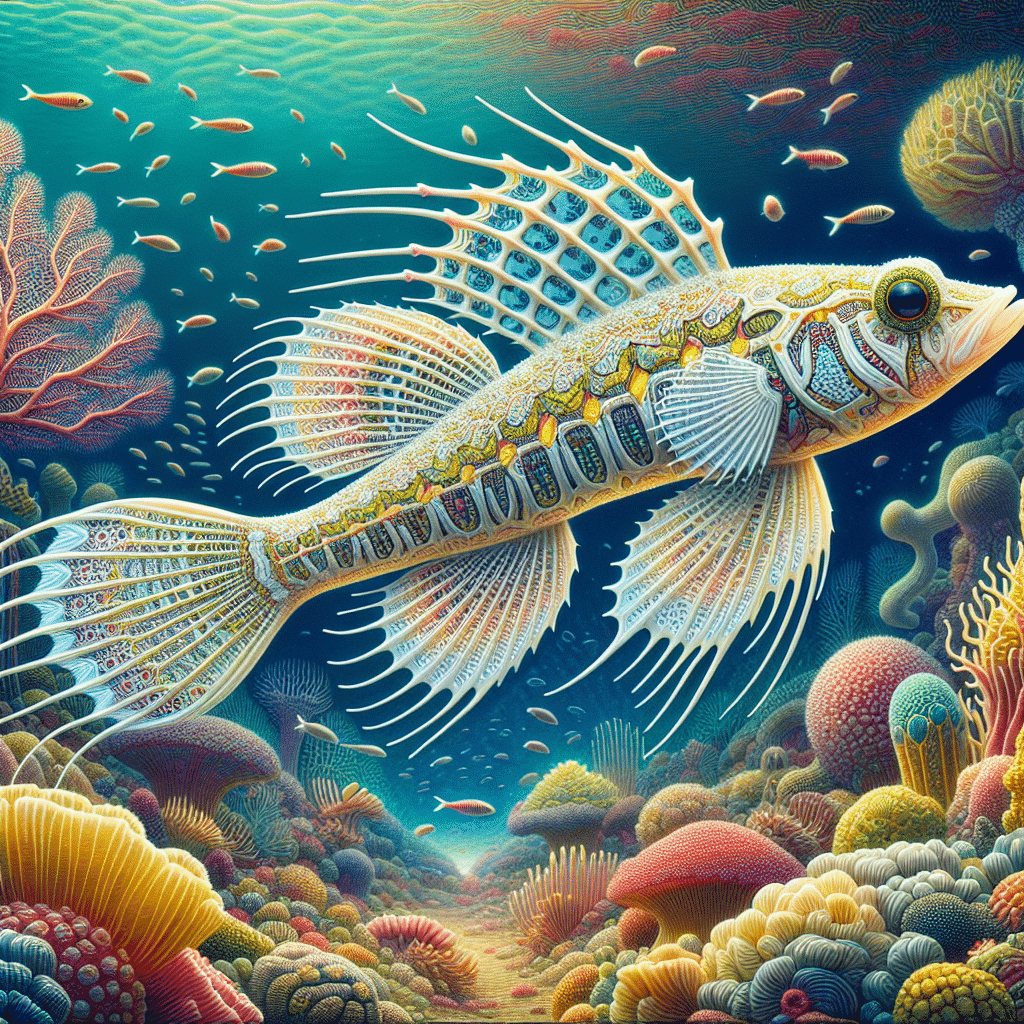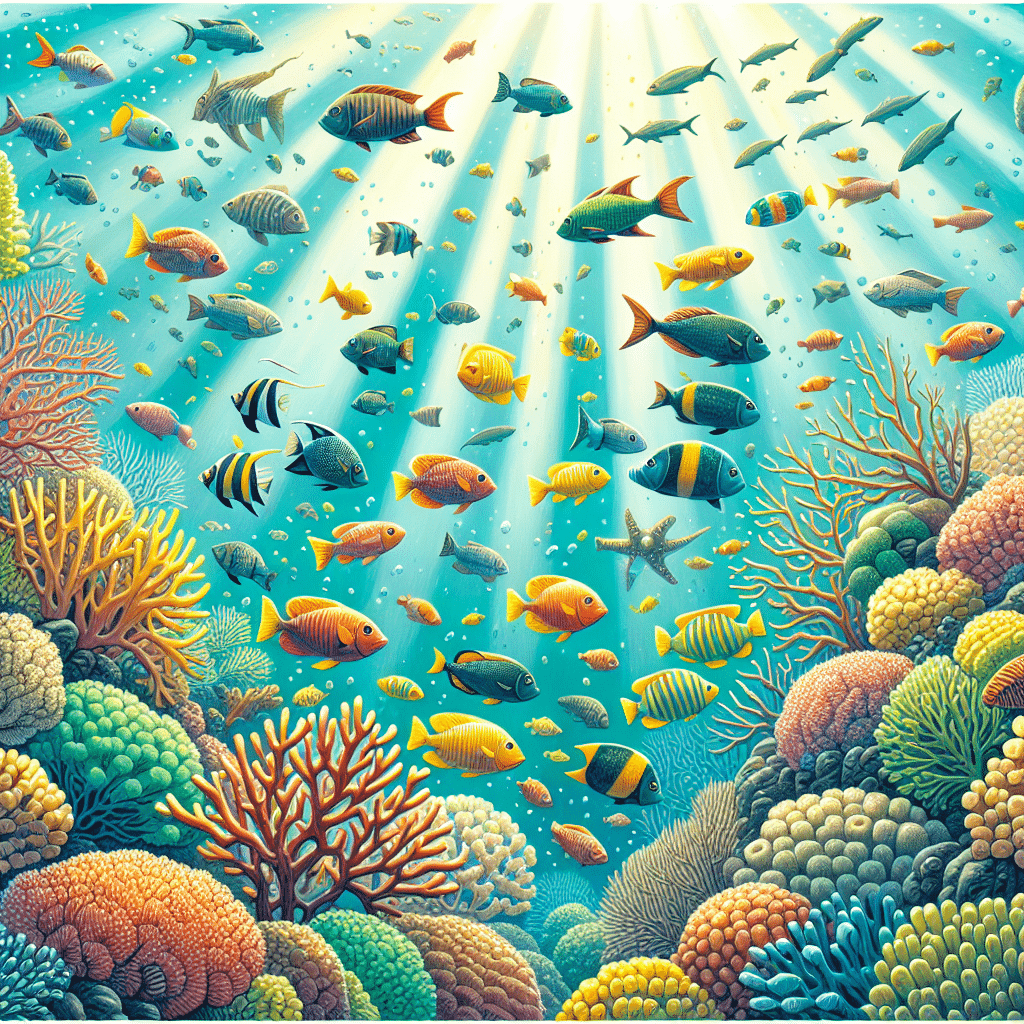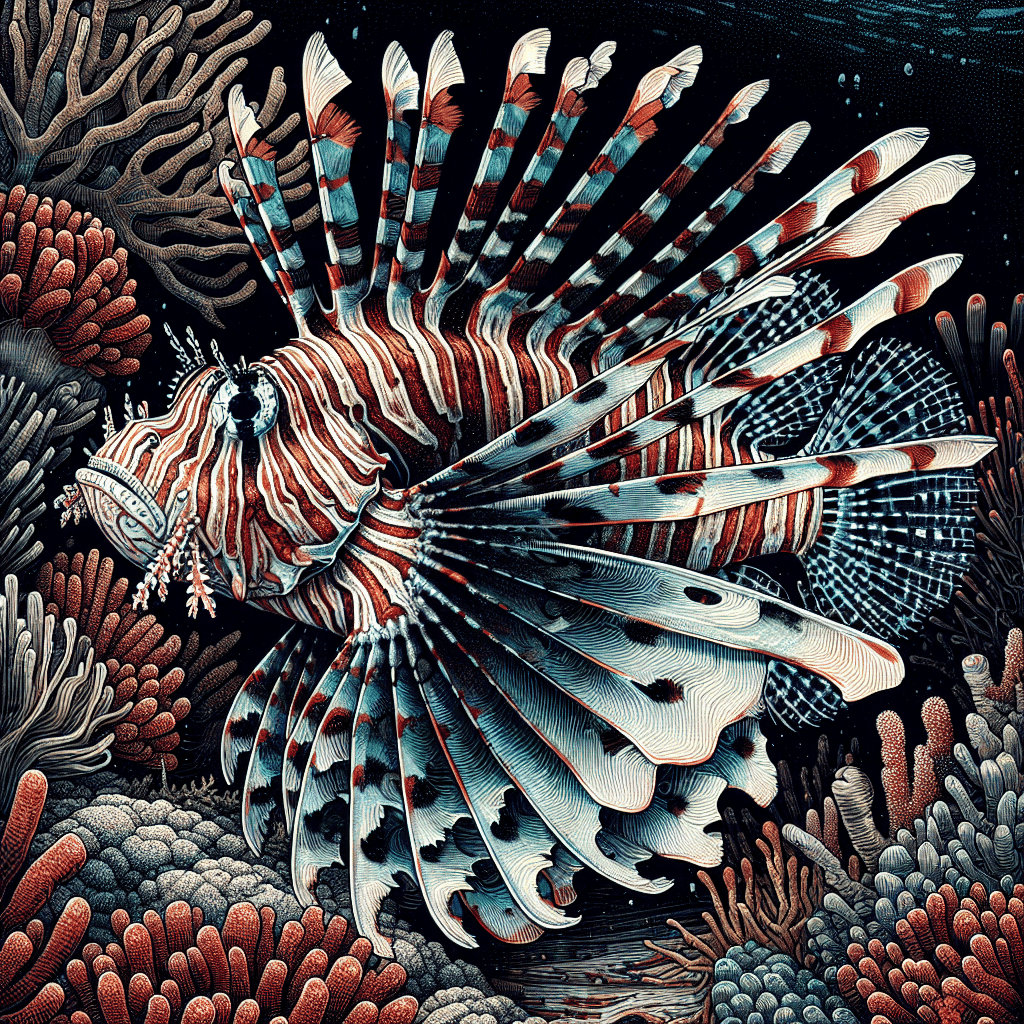Introduction to Diamond Goby
Exploring the Diamond Goby’s Role
I find the diamond goby, also known as the diamond watchman goby or orange spotted sleeper goby, to be a fantastic addition to my reef tank. These little guys play a valuable role in maintaining a clean and healthy aquarium environment. They sift through the sandbed for food, helping to prevent detritus buildup and anoxic zones, which can harm other tank inhabitants. Their burrowing activities also promote water circulation and sediment turnover, which is beneficial for the overall health of my coral reef.
Characteristics of the Diamond Goby
The diamond goby (Valenciennea puellaris) is a small fish species from the Gobiidae family, typically reaching up to 6 inches in length. I appreciate their pale to light gray bodies decorated with beautiful diamond-shaped patterns along their sides, which adds a unique aesthetic to my tank (Saltwaterfish.com). Here’s a quick overview of their key characteristics:
| Characteristic | Description |
|---|---|
| Size | Up to 6 inches |
| Color | Pale to light gray with diamond patterns |
| Behavior | Peaceful and reef safe |
| Tank Size | Recommended for aquariums of 30 gallons or larger |
| Special Needs | No special feeding requirements |
I’ve found that they are peaceful fish, making them a great choice for community tanks, although it’s best to avoid keeping them with other bottom feeders in small tanks. Additionally, I recommend having a screen top on the tank to prevent them from carpet surfing when startled.
Setting Up Your Aquarium
Setting up the perfect environment for your new diamond goby is essential for their health and happiness. I’ve found that understanding the ideal tank size and specific requirements can make a big difference in their care.
Ideal Tank Size for Diamond Gobies
Diamond gobies can grow up to 6 inches long. Therefore, it’s recommended to house them in aquariums of at least 30 gallons or larger. Keeping them in a spacious tank helps ensure they have enough room to swim and explore. I’ve seen that a 55-gallon long aquarium is particularly suitable for these fish, providing ample space and a more stable environment.
| Tank Size Recommendation | Minimum Size |
|---|---|
| Ideal for Diamond Gobies | 30 gallons |
| Recommended for more than one | 55 gallons |
Tank Requirements for Diamond Gobies
Creating the right habitat is crucial for diamond gobies. They thrive in a tank with a thick substrate of fine sand, as they are natural burrowers and sand sifters. Live rock is also beneficial for their environment, as it offers hiding spots and helps maintain water quality.
Here’s a checklist of tank requirements for diamond gobies:
- Tank Size: 30 gallons minimum; 55 gallons preferred
- Substrate: Thick layer of fine sand
- Decor: Live rock for burrowing and hiding
- Water Conditions: Stable temperature, good filtration, and regular water changes
- Lid: A tight-fitting lid is essential to prevent them from jumping out, especially when startled (Whitlyn Aquatics).
By ensuring these conditions, I’ve found that my diamond gobies not only thrive but also display their charming behaviors more freely. If you’re interested in other fish that could potentially share the tank with your goby, check out our articles on marine fish for more options.
Care and Feeding
Feeding Habits of Diamond Gobies
I’ve found that diamond gobies have pretty straightforward feeding habits. In the wild, they munch on copepods, detritus, and tiny invertebrates that live in the sand. When it comes to my home aquarium, I make sure they get a diet rich in (thawed) frozen or live brine shrimp, mysis shrimp, copepods, and other meaty foods. I usually feed them small amounts 2-3 times a day to keep them healthy and happy. They don’t have any special feeding requirements, so they readily accept most frozen or dry prepared foods, making them quite easy to care for (Whitlyn Aquatics).
| Food Type | Comments |
|---|---|
| Brine Shrimp | Live or frozen, a staple in their diet. |
| Mysis Shrimp | Great source of protein. |
| Copepods | Natural food source found in the wild. |
| Marine Pellets | Convenient option for daily feeding. |
Diamond Goby’s Diet in Captivity
In captivity, I’ve learned that it’s essential to provide a varied diet for my diamond goby. This ensures they get all the necessary nutrients to thrive. Their diet mainly consists of small invertebrates like worms, crustaceans, and other benthic organisms found in the sandy substrate. I often supplement their meals with some commercial marine pellet or flake foods to round out their nutrition (Saltwaterfish.com).
It’s important to note that diamond gobies can be kept in a tank as small as 55 gallons, as long as the aquarium has a thick substrate of fine sand and live rock. This setup allows them to burrow, which is a natural behavior for them. I also ensure that the tank has a tight-fitting lid because they can jump out if given the chance (FantaSEA Aquariums).
By providing a balanced diet and a suitable environment, I find that my diamond goby remains active and healthy, contributing to the overall ecosystem of my reef tank.
Behavior and Compatibility
Behavior Traits of Diamond Gobies
I find the behavior of diamond gobies quite fascinating. They are known for their burrowing habits, often digging themselves into the substrate to create a cozy home. This not only provides them with shelter but also helps them feel secure in their surroundings. One of the most interesting aspects of their behavior is their symbiotic relationship with pistol shrimp. The goby acts as a lookout for predators, while the shrimp diligently keeps the burrow clean and provides protection (Saltwaterfish.com).
Diamond gobies are generally peaceful and reef-safe. However, they can show signs of aggression towards fish that venture too close to their burrow or similar goby species. It’s worth noting that they are monogamous and have the ability to change sex from female to male. This flexibility can be particularly intriguing for hobbyists who enjoy observing unique fish behaviors.
Compatibility with Other Fish Species
When it comes to tank mates, diamond gobies tend to get along well with many species. They thrive in a community tank setting with other peaceful fish. Here’s a quick compatibility chart to give you an idea of which fish generally pair well with diamond gobies:
| Fish Species | Compatibility |
|---|---|
| Clownfish | Compatible |
| Tang (like Blue Tang) | Compatible |
| Pufferfish | May be compatible, but monitor closely |
| Butterfly Fish | Compatible |
| Triggerfish | Potentially aggressive; monitor behavior |
| Royal Gramma | Compatible |
| Lawnmower Blenny | Compatible |
While diamond gobies are friendly, it’s essential to monitor their interactions, especially with more aggressive species like triggerfish. Keeping a diverse tank can enhance the overall health and visual appeal of your aquarium. If you’re considering adding other types of fish, check out our articles on marine fish to explore more options.
Habitat and Environment
Natural Habitat of Diamond Gobies
Diamond gobies, scientifically known as Valenciennea puellaris, are fascinating little fish found primarily in the Indo-Pacific region. They inhabit a range of environments from the Red Sea to New Caledonia, including coastal areas, lagoons, and sandy substrates. These fish thrive in sandy environments where they can create burrows and intricate tunnel systems for shelter and hunting.
In their natural habitat, diamond gobies play a vital role by controlling the population of small invertebrates within the substrate and contributing to the overall health of coral reefs. Their burrowing activities help with water circulation and sediment turnover, which is crucial for reef ecosystems.
Creating the Ideal Tank Environment
Setting up the right environment for your diamond goby is essential for its health and well-being. Here are key factors to consider:
| Feature | Requirement |
|---|---|
| Tank Size | Minimum of 55-gallon long aquarium or larger |
| Substrate | Thick layer of fine sand for burrowing |
| Decorations | Live rock for shelter and hiding spots |
| Water Quality | Maintain stable salinity and pH levels |
| Cover | Tight-fitting lid to prevent jumping |
I always recommend using a thick substrate of fine sand, as diamond gobies are natural burrowers. They love to sift through the sand, so providing ample space for this behavior is key. Live rock not only offers shelter but also mimics their natural environment, making them feel more at home.
When keeping diamond gobies, it’s important to maintain good water quality. Regular water changes and monitoring salinity and pH levels will help keep your goby healthy. Ensuring that the aquarium has a tight-fitting lid is crucial as these little jumpers may try to escape.
Creating an ideal tank environment for a diamond goby can lead to a thriving and beautiful reef tank. For more tips on caring for your marine fish, check out our articles on various species like clownfish and tangs.
Breeding Diamond Gobies
Breeding diamond gobies can be an exciting yet challenging endeavor for aquarium hobbyists. This section covers the difficulties I encountered while trying to breed these fish, as well as how to care for the fry once they hatch.
Challenges of Breeding Diamond Gobies
One of the main challenges in breeding diamond gobies is the small size of the fry. When I first attempted it, I learned that pairing two healthy diamond gobies is the critical first step. Once paired, if conditions are right, the male will take on the responsibility of tending to the brood in a burrow.
The fry are incredibly tiny, making it difficult to provide appropriate food. It can be a bit frustrating, but understanding their needs is key. The success rate can vary, and it may take several attempts before achieving a successful breeding cycle.
Caring for Diamond Goby Fry
Once the fry have hatched, caring for them requires special attention. They need very tiny foods, like copepod nauplii, to survive and grow. This food is essential since their mouths are too small to handle larger particles.
| Fry Stage | Recommended Food |
|---|---|
| Newly hatched | Copepod nauplii |
| 1 week old | Rotifers |
| 2 weeks old | Baby brine shrimp |
As the fry grow, I found it beneficial to gradually introduce slightly larger foods to their diet while continuing to provide smaller options. Maintaining water quality is also crucial during this time, so regular monitoring and changes are necessary to keep the environment healthy.
Breeding and raising diamond gobies can be a rewarding experience, especially when watching the little fry grow. For more insights on keeping these fish, you might want to check out the section on marine fish and explore other species that can coexist with them, like clownfish and wrasse.
Fun Facts and Trivia
Fascinating Facts about Diamond Gobies
I’ve always found the Diamond Goby to be one of the most interesting fish in the reef tank. These little guys exhibit a range of captivating behaviors. For instance, they are known for their burrowing nature, which not only provides them with shelter but also helps with the health of their environment. Did you know that the Diamond Goby has a symbiotic relationship with pistol shrimp? The goby acts as a lookout for predators, while the shrimp keeps the burrow clean and offers protection. This teamwork is a fantastic example of how species can coexist in harmony (Saltwaterfish.com).
Another fascinating aspect of the Diamond Goby is its role in the ecosystem. It helps control the population of small invertebrates within the substrate, which is essential for maintaining a balanced environment. Their burrowing activities also facilitate water circulation and sediment turnover, benefiting coral reef health. It’s amazing how such a small fish can have such a significant impact on its habitat (Saltwaterfish.com).
| Feature | Description |
|---|---|
| Symbiotic Relationship | Acts as a lookout for pistol shrimp |
| Burrowing | Provides shelter and helps with water circulation |
| Ecosystem Role | Controls invertebrate populations and aids coral health |
Symbiotic Relationships in the Aquarium
In the aquarium, the Diamond Goby’s symbiotic relationships can enhance the overall health and dynamics of the tank. Their partnership with pistol shrimp is just one example. This relationship showcases how different species can work together to create a thriving environment.
Additionally, the Diamond Goby can coexist peacefully with various fish species, making it a great addition to a community tank. Just be sure to research the compatibility of other fish, like the clownfish or wrasse, to ensure a harmonious living arrangement.
The fascinating behaviors and ecological roles of the Diamond Goby not only make them a joy to observe but also a vital part of any reef tank. Their interactions with both the environment and other species highlight the importance of biodiversity in our aquariums.
Importance of Diamond Gobies
Ecological Role of Diamond Gobies
The diamond goby plays a vital role in its ecosystem by managing the population of small invertebrates within the substrate. This activity helps maintain the health and balance of the ecosystem. By burrowing, diamond gobies facilitate water circulation and sediment turnover, which are essential for the well-being of coral reefs (Saltwaterfish.com). Their burrowing also contributes to the overall nutrient cycling in the reef environment.
| Ecological Contribution | Description |
|---|---|
| Invertebrate Control | Helps regulate small invertebrate populations |
| Water Circulation | Promotes healthy water movement in the substrate |
| Sediment Turnover | Aids in nutrient cycling within the reef |
Impact on Reef Tank Ecosystems
In a reef tank setting, diamond gobies are beneficial as they sift through the substrate, keeping it aerated and clean. Their activities contribute to a healthier environment for other marine life. They are considered peaceful and reef-safe, making them a great addition to community tanks. However, it’s essential to house them in appropriate tank sizes—ideally 30 gallons or larger—to prevent overcrowding with other bottom feeders.
Due to their burrowing habits, diamond gobies require a thick substrate of fine sand to create their homes and tunnels. This not only provides them with shelter but also enhances the aesthetic appeal of the tank. Maintaining a tight-fitting lid is recommended to prevent them from jumping out when startled (Whitlyn Aquatics).
| Tank Requirements | Details |
|---|---|
| Minimum Tank Size | 30 gallons |
| Substrate Type | Fine sand |
| Ideal Companions | Other peaceful fish (avoid bottom feeders) |
The presence of diamond gobies not only enriches the biodiversity of reef tanks but also supports the overall health of the aquatic environment. Their unique behaviors, such as their symbiotic relationship with pistol shrimp, further add to their ecological significance.



